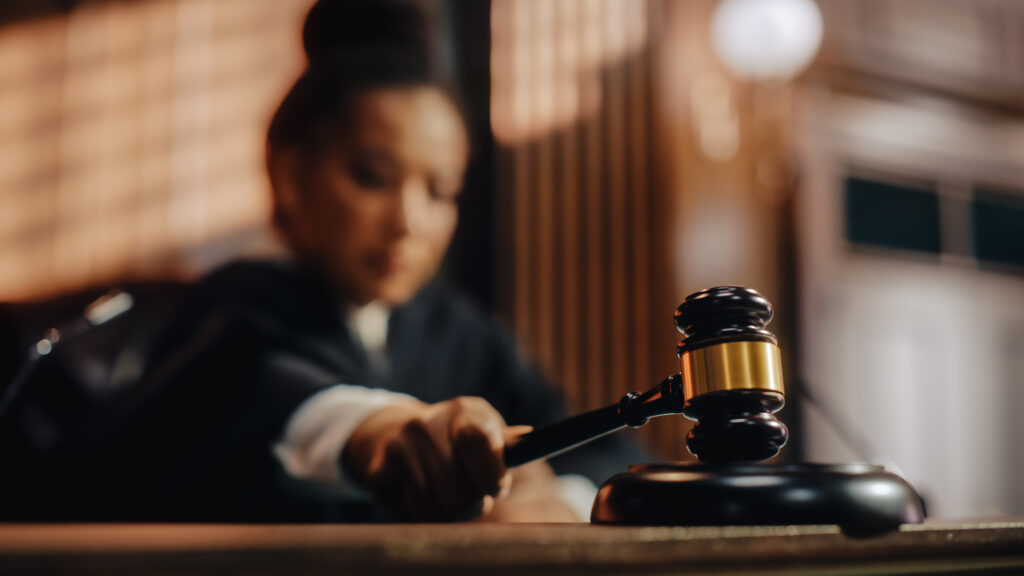
Indiana’s Supreme Court justices easily won retention with about 70% support of voters — about the same as in earlier, uneventful and uncontested retention elections. (Getty Images)
A few weeks ago, Indiana voters cast ballots that included at least a few — and in Marion County, several pages of — judicial candidates. Judicial races are usually unopposed and uneventful, but this year was a little different. I offer five takeaways.
Supreme Retention
Indiana Supreme Court justices face retention elections after two years on the bench and every ten years after that. The Indiana State Bar Association releases results of a survey from Indiana lawyers, but the elections seldom generate public attention.
But this year brought a social media campaign urging Hoosiers to vote against the retention of three justices whose ruling last year upheld a statute restricting abortion.
The justices easily won retention with about 70% support of voters—about the same as in earlier, uneventful and uncontested retention elections. Chief Justice Loretta Rush had the most votes (71%) while Justice Mark Massa had the fewest (69%). In contrast, two Arizona Supreme Court justices were retained with only 58 or 59% of the vote in the face of opposition over their recent decision in an abortion case. In 2012, Justice Steven David garnered 69% of the Indiana vote despite opposition from the right over an opinion he authored about the right of Hoosiers to resist unlawful police entry into their homes.
Although no Indiana justice has lost a retention election, voters in other states have occasionally ousted justices over unpopular rulings. Three Iowa justices were not retained in 2010 largely in response to a decision on same-sex marriage.
Female Judges Preferred by Marion County Voters
Eighteen Marion County judges—nine men and nine women—were on the ballot for retention. Every female judge earned 72-74% “yes” votes. With one exception, the male judges garnered 67-69% “yes” votes. Judge Jose Salinas received 72% “yes” votes.
The average, with Salinas included, was a nearly 5% edge—73.4% to 68.7%—for the female candidates.
Female judges generally fared a few points higher than male judges in St. Joseph County, although Judge Jamie Woods (a man with a unisex name) fared better than Judges Jeffrey Sanford and Mark Telloyan.
Experiments have suggested a partisan political dimension to how people view judges.
Another Good Year for “Republican” Judges
In all but a few counties, judges run for a six-year term in a partisan election. The “Democratic” label presents challenges for any candidate outside a few Indiana counties, and the same holds true in judicial elections. As reported by the Indiana Citizen, Democratic judges won just four races—three in Monroe County and one in Perry County; all four candidates were unopposed.
Republicans were unopposed in more than 70 races. They also knocked off two Democratic incumbent judges and took two open seats held by Democrats.
In Vanderburgh County, however, former Democratic State Rep. Ryan Hatfield won the nonpartisan race for Circuit Court after a costly campaign.
Democrats Competing for Judgeships in Hamilton County?
Hamilton County had three uncontested judicial elections (all Republicans) in 2024. That seems likely to change in the not-so-distant future.
Hamilton County was one of only 11% of counties where the Trump margin decreased in 2024 over 2020. The Republican candidates for president and governor each took less than 52% of the Hamilton County vote.
As a purely partisan matter, merit selection with appointments by the governor may look more appealing to Republicans, who have held the governor’s office since 2005. Regardless of politics, as an earlier column asked, why should Hamilton County, with a population of more than 350,000, elect its judges if St. Joseph County, with some 80,000 fewer residents cannot? A federal case challenging how Indiana structures its judicial elections in three of the state’s most diverse counties was argued in September and remains pending before the Seventh Circuit.
Woeful Turnout, Lack of Diversity in Lawyer Election
The 61% of eligible Hoosiers that voted on November 5 puts Indiana in the bottom ten of the fifty states. But another November election of importance for judicial selection had much lower turnout.
Nearly 4,400 lawyers in District 1 were sent electronic ballots to select an attorney member of the Judicial Nominating Commission. The seven-member JNC — three attorneys, three non-attorneys, and the Chief Justice — interviews and selects finalists for vacancies on the Indiana Supreme Court and Court of Appeals.
With fewer than 24% of attorneys casting a ballot, Steve Williams won with 340 votes. In more than 50 ballots over 50 years of voting, white men have won every election except once, in 2020. Nearly every attorney member has come from the plaintiff’s bar.
Appointments of non-attorney members by governors of both parties have been considerably more diverse.
GET THE MORNING HEADLINES.

